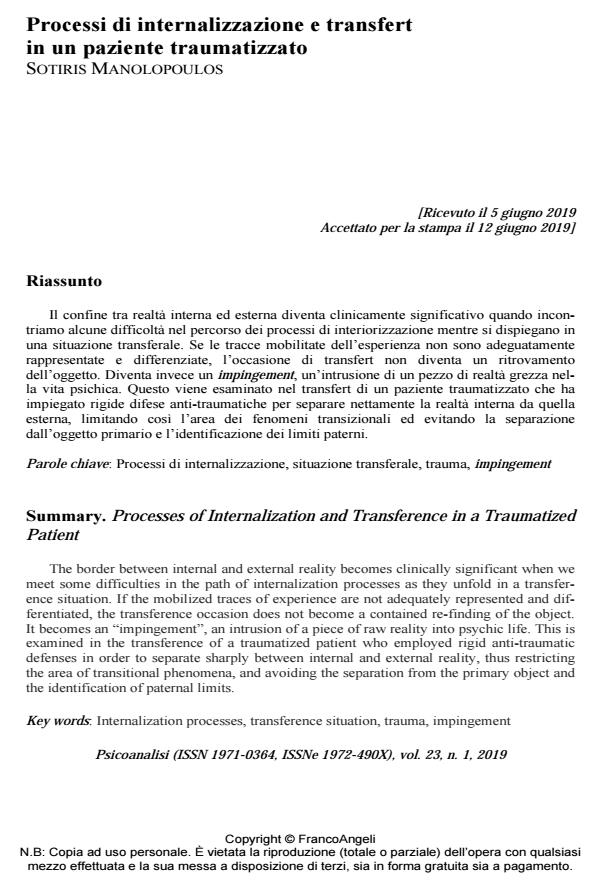Processi di internalizzazione e transfert in un paziente traumatizzato
Titolo Rivista PSICOANALISI
Autori/Curatori Sotiris Manolopoulos
Anno di pubblicazione 2019 Fascicolo 2019/1 Lingua Italiano
Numero pagine 14 P. 41-54 Dimensione file 181 KB
DOI 10.3280/PSI2019-001005
Il DOI è il codice a barre della proprietà intellettuale: per saperne di più
clicca qui
Qui sotto puoi vedere in anteprima la prima pagina di questo articolo.
Se questo articolo ti interessa, lo puoi acquistare (e scaricare in formato pdf) seguendo le facili indicazioni per acquistare il download credit. Acquista Download Credits per scaricare questo Articolo in formato PDF

FrancoAngeli è membro della Publishers International Linking Association, Inc (PILA)associazione indipendente e non profit per facilitare (attraverso i servizi tecnologici implementati da CrossRef.org) l’accesso degli studiosi ai contenuti digitali nelle pubblicazioni professionali e scientifiche
Il confine tra realtà interna ed esterna diventa clinicamente significativo quando incontria-mo alcune difficoltà nel percorso dei processi di interiorizzazione mentre si dispiegano in una situazione transferale. Se le tracce mobilitate dell’esperienza non sono adeguatamente rappre-sentate e differenziate, l’occasione di transfert non diventa un ritrovamento dell’oggetto. Di-venta invece un impingement, un’intrusione di un pezzo di realtà grezza nella vita psichica. Questo viene esaminato nel transfert di un paziente traumatizzato che ha impiegato rigide dife-se anti-traumatiche per separare nettamente la realtà interna da quella esterna, limitando così l’area dei fenomeni transizionali ed evitando la separazione dall’oggetto primario e l’identificazione dei limiti paterni.;
Keywords:Processi di internalizzazione, situazione transferale, trauma, impingement
- Aisenstein M. (2009). Discussion of Sander M. Abend’s “Freud, transference and therapeutic action”. Psychoanalytic Quarterly, 78: 893-901.
- Berg M. (2000). The internalizing transference. Canadian Journal of Psychoanalysis, 8, 2: 167-180.
- Bick E. (1968). The Experience of the Skin in Early Object-Relations. International Journal of Psychoanalysis, 49: 484-486.
- Bion W.R. (1965). Transformations. London: Karnac Books, 1984.
- Bleger J. (1967). Symbiosis and Ambiguity. London: Routledge, 2013.
- Bokanowski T. (2009). The splitting/trauma pairing: Ferenczi and the concept of trauma. In: Bokanowski T., Lewkowicz S. (eds), On Freud’s “Spliting of the Ego in the Process of Defence”. London: Karnac.
- Ferenczi S. (1913). Stages in the development of the sense of reality. In: First Contributions to Psychoanalysis. London: Maresfield Reprints, 1952.
- Ferenczi S. (1955). Final Contributions to the Problems and Methods of Psychoanalysis. London: Maresfield Reprints.
- Freud S. (1915a). Instincts and their vicissitudes. In: SE, 12.
- Freud S. (1915b). Observations on Tranference-love. In: SE.12.
- Freud S. (1916-1917). Introductory Lectures on Psycho-Analysis. In: SE, 15/16.
- Freud S. (1926). Inhibitions, Symptoms and Anxiety. In: SE, 20.
- Freud S. (1940). An Outline of Psychoanalysis. In: SE, 23.
- Gaddini E. (1987). Notes on the mind-body question. Int. Journal of Psychoanal., 68: 5-329.
- Green A. (2005). Key Ideas for a Contemporary Psychoanalysis. Misrecognition and Recognition of the Unconscious. London: Routledge.
- Loewald H. (1960). On the therapeutic action of psychoanalysis. Int. Journal of Psychoanal. 41: 16-33.
- Perelberg R.J. (2018). The riddle of anxiety: Between the familiar and the unfamiliar. Int. Journal of Psychoanal., 99, 4: 810-827. DOI: 10.1080/00207578.2018.1452571
- Ribas D. (2015). Genesis, primal scene, and self-engederment. In: Saragano G., Seulin C. (eds), Playing and Reality Revisited. A new Look at Wnnicott’s Classic Work. London: Karnac.
- Rosenfeld H. (1987). Impasse and interpretation: Therapeutic and Antitherapeutic Factors in the Psychoanalytic Treatment of Psychotic, Borderline, and Neurotic Patients. London: Tavistock.
- Roussillon R. (2010). The deconstruction of primary narcissism. Int. Journal of Psychoanal., 91, 4: 821-837.
- Spitz R.A., Wolf K.M. (1946). Anaclitic depression. An inquiry into the genesis of psychiatric conditions in early childhood. Psychoanalytic Study of the Child, 2: 313-342.
- Starchey J. (1934). The nature of the therapeutic action. Int. Journal of Psychoanal., 15: 127-159.
- Winnicott D.W. (1960a). The theory of parent-infant relationship. In: The maturational Process and the Facilitating Environment. London: Karnac Books, 1990.
- Winnicott D.W. (1971). Playing and Reality. London: Tavistock.
- Winnicott D.W. (1988). Human Nature. London: Free Association Press.
Sotiris Manolopoulos, Processi di internalizzazione e transfert in un paziente traumatizzato in "PSICOANALISI" 1/2019, pp 41-54, DOI: 10.3280/PSI2019-001005